Acleris forsskaleana
Acleris forsskaleana, the maple leaftier moth, is a moth of the family Tortricidae. It is found in Europe and North America[1] in woodlands and gardens.
| Acleris forsskaleana | |
|---|---|
 | |
| Scientific classification | |
| Domain: | Eukaryota |
| Kingdom: | Animalia |
| Phylum: | Arthropoda |
| Class: | Insecta |
| Order: | Lepidoptera |
| Family: | Tortricidae |
| Genus: | Acleris |
| Species: | A. forsskaleana |
| Binomial name | |
| Acleris forsskaleana | |
| Synonyms | |
| |
The wingspan is 12–17 mm. The ground colour of the forewings is yellowish underlying a reticulated darker pattern and a greyish suffusion across the disc. Julius von Kennel provides a full description. [2]
The moth flies from June to September from dusk onwards.
The main food plants in Europe are field maple (Acer campestre) and sycamore (A. pseudoplatanus); the larvae can also be found on Norway maple (A. platanoides).
The name honours Peter Forsskål.
References
- Opler, Paul A.; Kelly Lotts; Thomas Naberhaus. "Acleris forsskaleana". Butterflies and Moths of North America. Retrieved 12 February 2014.
- Julius von Kennel, 1921, The Palaearktischen Tortriciden, eine monographische Darstellung. Stuttgart: E. Schweizerbart'sche Verlagsbuchhandlung. 742 pp. - Palaearctic Tortricidae, a monograph.pdf at Zobodat 170
External links
 Media related to Acleris forsskaleana at Wikimedia Commons
Media related to Acleris forsskaleana at Wikimedia Commons- waarneming.nl (in Dutch).
- Lepidoptera of Belgium
- Acleris forsskaleana at UKMoths
This article is issued from Wikipedia. The text is licensed under Creative Commons - Attribution - Sharealike. Additional terms may apply for the media files.